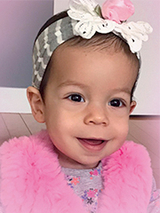

Inspired by the brief, precious life of a girl named Mila, physicians at Children's Hospital of Philadelphia (CHOP) and Mila’s parents have joined forces to solve the problem of getting accurate blood pressure readings in very small children.
Mila was 2 months old when she was diagnosed with neurofibromatosis type 1 (NF1), a genetic disorder. Having NF1 increases a child’s risk for learning disabilities, bony changes, skin growths and certain low grade tumors of the nervous system. In rare cases, NF1 is also associated with vascular problems that may result in hypertension (high blood pressure).
Mila was one of these rare cases, and her hypertension went undetected until she was 14 months old. One of her blood pressure readings was an alarmingly high 240/110. Medication did not lower it, so she underwent vascular surgery. Shortly after the operation, Mila went into cardiac arrest and did not survive.
Through their grief, Mila’s parents, Jessica and Dan Roomberg, were determined to act. They created a nonprofit, the Magical Mila Foundation, in 2019. They enlisted clinicians at Children's Hospital of Philadelphia (CHOP) to launch the BP Under 3 initiative to help find a way to ensure that blood pressure measurements are accurately taken for every very young child at risk of hypertension.
Three goals to better BP readings
“It’s quite difficult to take blood pressure, and take it accurately, in children under 3 years old,” says Kevin Meyers, MBBCh, Director of the Hypertension Clinic at CHOP. Very young children don’t stay still and can get upset by the discomfort of the blood pressure cuff squeezing their arm.
“When we tried to take Mila’s blood pressure at home, we experienced how hard it is,” says Jessica Roomberg. “Mila would cry.”
“The reality is that blood pressure is not being obtained in the children under 3 who need them to be obtained on a regular basis,” says Rachel Hachen, MD, MPH, Medical Director of the Pediatric Neurofibromatosis Program in the Division of Pediatrics. To solve this problem, the BP Under 3 initiative started in 2020 at CHOP with three goals:
- Identify a better blood pressure device to use with this age group. They carefully evaluated a device used at CHOP for children older than 3 years to determine how well it works in younger children. They validated its accuracy and got it approved by CHOP for use. “It works better in younger children,” Meyers explains. “There’s less squeeze, so it’s much better tolerated.”
- Create a reminder so the reading gets taken. At a child’s well visit at a CHOP primary care office, if the child is in a high-risk category to develop hypertension, the electronic medical record now automatically shows an alert reminding the medical staff to get a blood pressure reading. The alert also includes the correct steps for taking and recording the measurement. “It’s very user-friendly,” says Hachen.
- Educate CHOP staff how and why blood pressure must be taken in these children. “We conducted a huge educational campaign at CHOP,” says Meyers. The campaign included posters created by the Magical Mila Foundation, webinars, in-person training and more.
As a result of these successful steps, “The culture is being changed about obtaining blood pressure at CHOP,” says Meyers. “We have groups reach out to us, saying, ‘Help us do this better.’”
Now, the BP Under 3 initiative is gaining attention beyond CHOP’s walls. The team intends to partner with pediatric hospitals throughout the northeast region. And there’s already national interest.
“Our main goal was always to get this known nationwide,” says Dan Roomberg. The Roombergs reached out to the American Association of Pediatrics (AAP) to inform them about the initiative. Subsequently, when the AAP received a grant to improve clinical excellence in children, the organization chose high blood pressure in very young children as one area of focus. “The fact that we are working with the AAP means so much to us.”
Since its founding, the Magical Mila Foundation has raised more than $400,000, which has all been donated CHOP. “This is a lifelong commitment for us,” says Jessica Roomberg. “Mila is our motivation. We do it all for her.”
Featured in this article
Specialties & Programs

Inspired by the brief, precious life of a girl named Mila, physicians at Children's Hospital of Philadelphia (CHOP) and Mila’s parents have joined forces to solve the problem of getting accurate blood pressure readings in very small children.
Mila was 2 months old when she was diagnosed with neurofibromatosis type 1 (NF1), a genetic disorder. Having NF1 increases a child’s risk for learning disabilities, bony changes, skin growths and certain low grade tumors of the nervous system. In rare cases, NF1 is also associated with vascular problems that may result in hypertension (high blood pressure).
Mila was one of these rare cases, and her hypertension went undetected until she was 14 months old. One of her blood pressure readings was an alarmingly high 240/110. Medication did not lower it, so she underwent vascular surgery. Shortly after the operation, Mila went into cardiac arrest and did not survive.
Through their grief, Mila’s parents, Jessica and Dan Roomberg, were determined to act. They created a nonprofit, the Magical Mila Foundation, in 2019. They enlisted clinicians at Children's Hospital of Philadelphia (CHOP) to launch the BP Under 3 initiative to help find a way to ensure that blood pressure measurements are accurately taken for every very young child at risk of hypertension.
Three goals to better BP readings
“It’s quite difficult to take blood pressure, and take it accurately, in children under 3 years old,” says Kevin Meyers, MBBCh, Director of the Hypertension Clinic at CHOP. Very young children don’t stay still and can get upset by the discomfort of the blood pressure cuff squeezing their arm.
“When we tried to take Mila’s blood pressure at home, we experienced how hard it is,” says Jessica Roomberg. “Mila would cry.”
“The reality is that blood pressure is not being obtained in the children under 3 who need them to be obtained on a regular basis,” says Rachel Hachen, MD, MPH, Medical Director of the Pediatric Neurofibromatosis Program in the Division of Pediatrics. To solve this problem, the BP Under 3 initiative started in 2020 at CHOP with three goals:
- Identify a better blood pressure device to use with this age group. They carefully evaluated a device used at CHOP for children older than 3 years to determine how well it works in younger children. They validated its accuracy and got it approved by CHOP for use. “It works better in younger children,” Meyers explains. “There’s less squeeze, so it’s much better tolerated.”
- Create a reminder so the reading gets taken. At a child’s well visit at a CHOP primary care office, if the child is in a high-risk category to develop hypertension, the electronic medical record now automatically shows an alert reminding the medical staff to get a blood pressure reading. The alert also includes the correct steps for taking and recording the measurement. “It’s very user-friendly,” says Hachen.
- Educate CHOP staff how and why blood pressure must be taken in these children. “We conducted a huge educational campaign at CHOP,” says Meyers. The campaign included posters created by the Magical Mila Foundation, webinars, in-person training and more.
As a result of these successful steps, “The culture is being changed about obtaining blood pressure at CHOP,” says Meyers. “We have groups reach out to us, saying, ‘Help us do this better.’”
Now, the BP Under 3 initiative is gaining attention beyond CHOP’s walls. The team intends to partner with pediatric hospitals throughout the northeast region. And there’s already national interest.
“Our main goal was always to get this known nationwide,” says Dan Roomberg. The Roombergs reached out to the American Association of Pediatrics (AAP) to inform them about the initiative. Subsequently, when the AAP received a grant to improve clinical excellence in children, the organization chose high blood pressure in very young children as one area of focus. “The fact that we are working with the AAP means so much to us.”
Since its founding, the Magical Mila Foundation has raised more than $400,000, which has all been donated CHOP. “This is a lifelong commitment for us,” says Jessica Roomberg. “Mila is our motivation. We do it all for her.”
Contact us
Hypertension Clinic